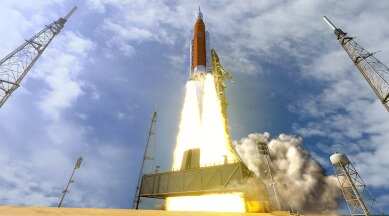NASA’s Artemis 1 launch to the Moon

After months of testing, troubleshooting and repairs, engineers began fueling the Artemis 1 Space Launch System moon rocket for blastoff Monday to send an uncrewed Orion capsule on a 42-day trip around the moon.
After midnight, rain showers accompanied by lightning struck within five nautical miles of Launch Pad 39B, forcing launch director Charlie Blackwell-Thompson to delay the start of propellant loading by 55 minutes. But the six-hour process finally began at 1:13 a.m. EDT.
Subsequently, a hydrogen leak was discovered during refueling.
Another problem as the countdown ticked into its final hours was troubleshooting to find the cause of a momentary communications error in a channel relaying command and telemetry to and from the Orion spacecraft.
Another possible problem is a leak of some sort, a crack in the thermal insulation or other problem seen on the outside of the rocket’s core stage.
It was not immediately clear what impact the problems might have on the scheduled 8:33 a.m. launch time.
Engineers hoped to get the most powerful rocket ever built by NASA on its long-awaited first flight sometime during the two-hour launch window.
Loading 196,000 gallons of liquid oxygen and 537,000 gallons of hydrogen into the rocket’s massive core stage required a carefully scripted fueling process. The upper stage required another 22,000 gallons of oxygen and hydrogen, for a total of 750,000 gallons of propellant.
The SLS’s four shuttle-era engines and two extended strap-on solid fuel boosters will produce 8.8 million pounds of thrust to propel the 5.7-million pound rocket from Pad 39B at Kennedy Space Center.
The rocket portion of the Artemis 1 mission will last just one hour and 36 minutes, propelling the Orion capsule and its European Space Agency-supplied service module into space, beyond Earth orbit and toward the Moon.
After a close flyby at an altitude of just 60 miles, Orion will return to a distant orbit around the moon for two weeks of tests and checkout. If all goes well, the capsule will retreat toward the moon for another close flyby on Oct. 3 that will set up a high-speed descent for a splashdown in the Pacific Ocean on Oct. 10.
NASA plans to follow the Artemis 1 mission by launching four astronauts on a looping flight around the moon in 2024, setting the stage for the first astronaut landing in nearly 50 years, when the first woman and the next man set foot on Earth’s surface. 2025-26 period.
But first, NASA must prove that the rocket and capsule will work as planned, and that starts with Monday’s Artemis 1 launch.
About 6.6 seconds before launch, the four RS-25 engines at the base of the core stage will ignite and throttle to full thrust, producing a combined two million pounds of thrust.
When the countdown reaches zero, commands will be sent to ignite both solid rocket boosters, followed by a computer lightning round to verify engine performance. At the same moment, the signal will fire four explosive bolts at the base of each booster, freeing the SLS from its launch pad.
Solid rocket boosters provide the lion’s share of the power needed to lift the SLS out of the dense lower atmosphere, firing for two minutes and 10 seconds before falling away at an altitude of 27 miles.
The RS-25 core stage engines themselves will continue the ascent, firing for another six minutes to take the rocket to an altitude of 87 miles.
The core stage’s RS-25 engines would fire for eight minutes, raising the ship to an altitude of 87 miles before shutting down.
The flight plan called for the rocket’s upper stage, carrying an unmanned Orion capsule and a service module supplied by the European Space Agency, to separate from the now-empty core stage and continue coasting toward the sky at an altitude of about 1,100 miles. apogee, in its initial orbit.
The engines powering the Interim Cryogenic Propulsion Stage, or ICPS, were expected to raise the orbit’s low point, or perigee, from 20 miles to 115, 51 minutes after liftoff.
Reaching that low point forty-five minutes later — one hour and 36 minutes after launch — the ICPS was programmed to fire its RL10B engines for 18 minutes, accelerating the vehicle to about 22,600 mph, 10 times faster than a rifle bullet.
This is what it takes to break free from Earth’s gravity, raising the apogee to the point in space where the Moon will be in five days.
After deploying its four solar wings and separating from the ICPS, the Orion capsule will head for a 60-mile-high flyby of the moon on Sept. 3 and then into a “distant retrograde orbit” that takes the spacecraft farther from Earth — 280,000 miles. — than any previous human-rated spacecraft.